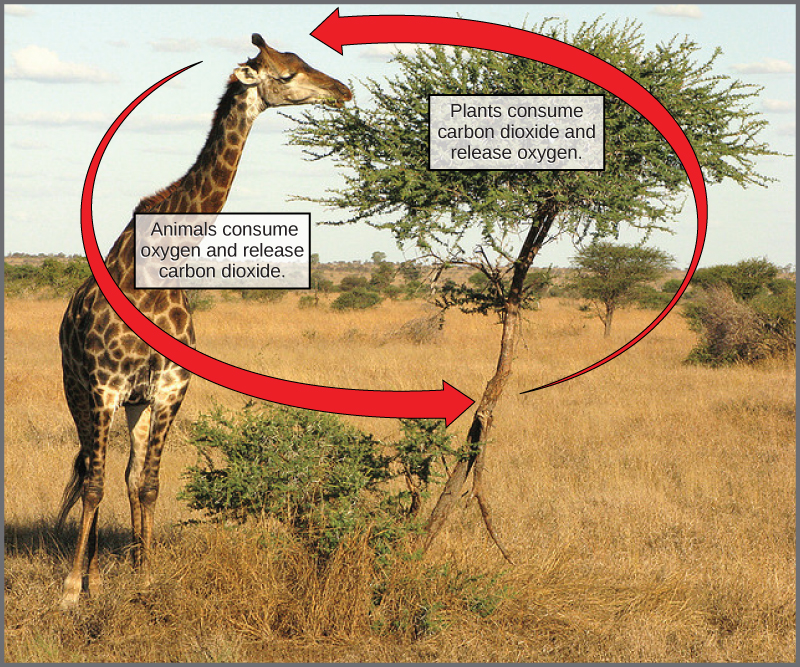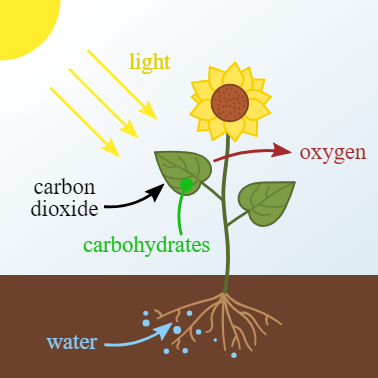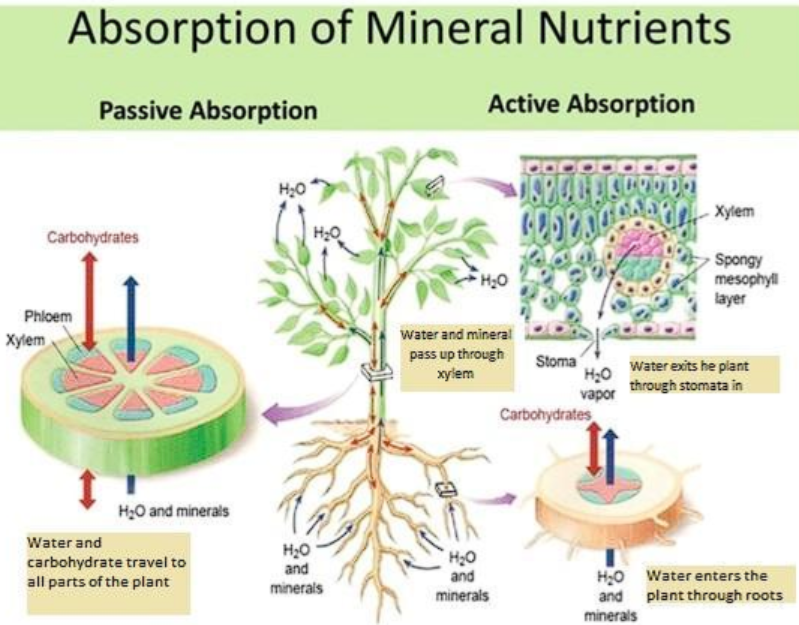7.01 Plant Overview
Key Concepts
Food and Nutrient Sources:
- Animals obtain food by consuming organic materials.
- Plants make their own food through photosynthesis and obtain water and minerals from the soil.

Plant Structure and Nutrient Acquisition:
- Leaves:
- Primary site for photosynthesis and production of sugars.
- Positioned above ground to capture sunlight.
- Roots:
- Extensive root systems spread out below ground to absorb water and minerals.
- Roots collect essential ions like magnesium, which is transported to leaves to produce chlorophyll for photosynthesis.

Need for Transport System in Plants:
- Sugars (e.g., glucose produced by photosynthesis in leaves) are required throughout the plant for respiration and cellulose synthesis.
- Minerals (e.g., magnesium absorbed by roots) are transported to leaves and other parts for various functions.
- Long-Distance Transport:
- Essential to distribute water, minerals, and sugars throughout the plant body to meet cellular needs.

Practice Question 1
1. The transport sugar made in leaves is the disaccharide, sucrose.
- Answer: Cellulose synthesis is most needed in regions of active growth, such as shoot and root tips, where new cells are being formed and require cell walls.
2. Define a disaccharide.
- Answer: A disaccharide is a carbohydrate composed of two monosaccharide molecules joined together by a glycosidic bond.
3. What monosaccharides are used to make sucrose?
- Answer: Glucose and fructose are the monosaccharides that combine to form sucrose.
4. Which isomer of glucose is used to make cellulose?
- Answer: Beta-glucose is the isomer used to form cellulose.
5. Which isomer of glucose is used to make starch?
- Answer: Alpha-glucose is the isomer used to synthesize starch.
6. Where in the plant would the process of making cellulose most be needed and why?
Answer: Cellulose synthesis is most needed in regions of active growth, such as shoot and root tips, where new cells are being formed and require cell walls.
Practice Question 2
Question 1
Compare how animals and plants obtain their food. (5 marks)
Mark Scheme:
- Animals Obtain Food by Consuming Organic Materials:
- Animals are heterotrophic, meaning they consume other organisms or organic matter for energy and nutrients. (1 mark)
- Plants Make Their Own Food through Photosynthesis:
- Plants are autotrophic, capable of synthesizing their own food using sunlight, carbon dioxide, and water through photosynthesis. (1 mark)
- Energy Source:
- Animals rely on external sources of energy by ingesting food.
- Plants generate energy internally through photosynthesis. (1 mark)
- Nutrient Acquisition:
- Plants obtain water and minerals from the soil through their roots. (1 mark)
- Dependency on Environment:
- Animals depend on the availability of food sources in their environment.
- Plants depend on sunlight, water, and soil nutrients for food production. (1 mark)
Question 2
Describe the role of leaves in plant nutrient acquisition and their structural adaptations for this role. (6 marks)
Mark Scheme:
- Primary Site for Photosynthesis:
- Leaves are the main location where photosynthesis occurs, producing sugars from sunlight, carbon dioxide, and water. (1 mark)
- Production of Sugars:
- Through photosynthesis, leaves synthesize glucose and other sugars essential for the plant’s energy and growth. (1 mark)
- Positioned Above Ground to Capture Sunlight:
- Leaves are typically located above ground, maximizing sunlight exposure necessary for efficient photosynthesis. (1 mark)
- Large Surface Area:
- Leaves have a broad, flat surface area to capture more sunlight and facilitate gas exchange. (1 mark)
- Stomata:
- Leaves contain stomata, which are pores that allow for the exchange of gases (intake of CO₂ and release of O₂). (1 mark)
- Chloroplasts:
- Leaves are rich in chloroplasts, the organelles where chlorophyll resides and photosynthesis takes place. (1 mark)
Question 3
Explain how root structure facilitates nutrient and water absorption in plants. (5 marks)
Mark Scheme:
- Extensive Root Systems:
- Roots spread out extensively into the soil, increasing the surface area for absorption of water and minerals. (1 mark)
- Root Hairs:
- Fine extensions called root hairs increase the surface area and contact with soil particles, enhancing absorption efficiency. (1 mark)
- Selective Absorption:
- Roots selectively absorb essential ions and minerals (e.g., magnesium, potassium) necessary for plant functions. (1 mark)
- Transport to Leaves:
- Absorbed water and minerals are transported from the roots to the leaves through xylem vessels for use in photosynthesis and other metabolic processes. (1 mark)
- Symbiotic Relationships:
- Roots often form symbiotic relationships with mycorrhizal fungi, which aid in the absorption of nutrients like phosphorus. (1 mark)
Question 4
Discuss the necessity of a transport system in plants. (5 marks)
Mark Scheme:
- Distribution of Sugars:
- Sugars produced in the leaves during photosynthesis are required throughout the plant for respiration and cellulose synthesis. (1 mark)
- Distribution of Minerals:
- Minerals and water absorbed by the roots need to be transported to the leaves and other parts for various metabolic functions. (1 mark)
- Long-Distance Transport:
- Essential for distributing resources efficiently across the entire plant body, ensuring all cells receive necessary nutrients and water. (1 mark)
- Support of Growth and Development:
- Transport systems support the growth, development, and repair of plant tissues by delivering required substances to specific locations. (1 mark)
- Maintenance of Homeostasis:
- Helps in maintaining internal balance by regulating the distribution of water and nutrients according to the plant’s needs. (1 mark)
Question 5
Identify and describe the two main types of transport tissues in plants and their functions. (6 marks)
Mark Scheme:
- Xylem:
- Function: Transports water and inorganic ions from the roots to other parts of the plant. (1 mark)
- Structure: Composed of tracheids and vessels, which are hollow, tube-like cells that facilitate upward water movement. (1 mark)
- Phloem:
- Function: Transports organic compounds (mainly sugars like sucrose) from the leaves to other parts of the plant. (1 mark)
- Structure: Composed of sieve tubes and companion cells, which are specialized for the bidirectional movement of nutrients. (1 mark)
- Xylem and Phloem Arrangement:
- Both tissues are arranged in vascular bundles within the plant, allowing for efficient transport through the plant body. (1 mark)
- Role in Growth:
- Xylem provides the necessary water for cellular processes, while phloem supplies energy needed for growth and development. (1 mark)
- Support and Stability:
- Xylem also contributes to the structural support of the plant due to its rigid, lignified cell walls. (1 mark)
Question 6
Explain how magnesium is transported from roots to leaves and its role in photosynthesis. (5 marks)
Mark Scheme:
- Absorption by Roots:
- Magnesium is absorbed by the roots from the soil through active transport mechanisms. (1 mark)
- Transport via Xylem:
- Once absorbed, magnesium ions are transported from the roots to the leaves through the xylem vessels. (1 mark)
- Role in Chlorophyll Production:
- Magnesium is a central component of the chlorophyll molecule, essential for capturing light energy during photosynthesis. (1 mark)
- Activation of Enzymes:
- Magnesium acts as a cofactor for various enzymes involved in the photosynthetic process, facilitating biochemical reactions. (1 mark)
- Importance for Photosynthesis:
- Without sufficient magnesium, chlorophyll production is impaired, leading to reduced photosynthetic efficiency and growth. (1 mark)
Question 7
Describe the process by which sugars produced in the leaves are transported to other parts of the plant. (6 marks)
Mark Scheme:
- Photosynthesis in Leaves:
- Sugars such as glucose are produced in the leaves through photosynthesis. (1 mark)
- Loading into Phloem:
- Sugars are actively transported into the phloem sieve tubes in the vascular bundles of the leaves. (1 mark)
- Pressure Flow Mechanism:
- The movement of sugars through the phloem is driven by a pressure flow mechanism, where the high concentration of sugars in the phloem creates an osmotic gradient that pulls in water, generating turgor pressure that drives the flow. (2 marks)
- Unloading in Target Areas:
- Sugars are unloaded from the phloem into sink tissues (e.g., roots, stems, fruits) where they are used for respiration, growth, and storage. (1 mark)
- Energy and Storage:
- In sink tissues, sugars are either used immediately for energy or converted into storage forms like starch. (1 mark)
Question 8
Explain why long-distance transport is essential in plants, using examples of transported substances and their functions. (5 marks)
Mark Scheme:
- Distribution of Water and Minerals:
- Water and minerals absorbed by the roots are transported to the leaves and other parts where they are needed for photosynthesis and metabolic processes. (1 mark)
- Distribution of Sugars:
- Sugars produced in the leaves during photosynthesis are distributed to sink tissues for respiration, growth, and cellulose synthesis. (1 mark)
- Support of Growth:
- Long-distance transport ensures that all parts of the plant, including growing tips and storage organs, receive the necessary nutrients and energy. (1 mark)
- Maintenance of Homeostasis:
- Balances the internal distribution of resources, preventing local shortages and ensuring overall plant health. (1 mark)
- Examples of Transported Substances:
- Magnesium transported to leaves for chlorophyll production; glucose transported to roots for energy storage. (1 mark)
Question 9
Compare the roles of leaves and roots in nutrient acquisition and explain how their structures are adapted to these roles. (6 marks)
Mark Scheme:
- Leaves:
- Role: Primary site for photosynthesis, producing sugars needed for energy and growth.
- Structure Adaptations:
- Large Surface Area: Maximizes sunlight capture.
- Stomata: Facilitate gas exchange (intake of CO₂, release of O₂).
- Chloroplasts: Contain chlorophyll for light absorption. (2 marks)
- Roots:
- Role: Absorb water and minerals from the soil, supplying essential nutrients to the plant.
- Structure Adaptations:
- Extensive Root Systems: Increase surface area for absorption.
- Root Hairs: Enhance contact with soil particles, improving absorption efficiency.
- Mycorrhizal Associations: Form symbiotic relationships with fungi to aid in nutrient uptake. (2 marks)
- Functional Integration:
- Leaves produce sugars that are transported to other parts of the plant, while roots supply the necessary water and minerals to support photosynthesis and growth. (1 mark)
- Structural Coordination:
- Leaves and roots are strategically positioned (leaves above ground, roots below) to optimize their respective functions in nutrient acquisition and resource distribution. (1 mark)
Question 10
Explain how the transport system in plants maintains the distribution of essential nutrients and energy throughout the plant body. (6 marks)
Mark Scheme:
- Xylem Transport:
- Function: Transports water and dissolved minerals from the roots to the leaves and other aerial parts. (1 mark)
- Phloem Transport:
- Function: Transports sugars produced in the leaves to sink tissues (e.g., roots, fruits) for energy use and storage. (1 mark)
- Pressure Flow Mechanism:
- Phloem movement is driven by a pressure gradient created by active loading of sugars into the phloem, which draws in water and generates turgor pressure to push the sap through the phloem. (1 mark)
- Role of Xylem in Mineral Distribution:
- Minerals like magnesium are transported via the xylem to support chlorophyll production and photosynthesis in the leaves. (1 mark)
- Role of Phloem in Energy Distribution:
- Sugars are distributed to areas requiring energy for respiration, growth, and cellulose synthesis, ensuring all parts of the plant receive the necessary resources. (1 mark)
- Coordination and Regulation:
- The transport system coordinates the distribution based on the plant’s metabolic needs, adjusting the flow of water, minerals, and sugars to different parts as required. (1 mark)